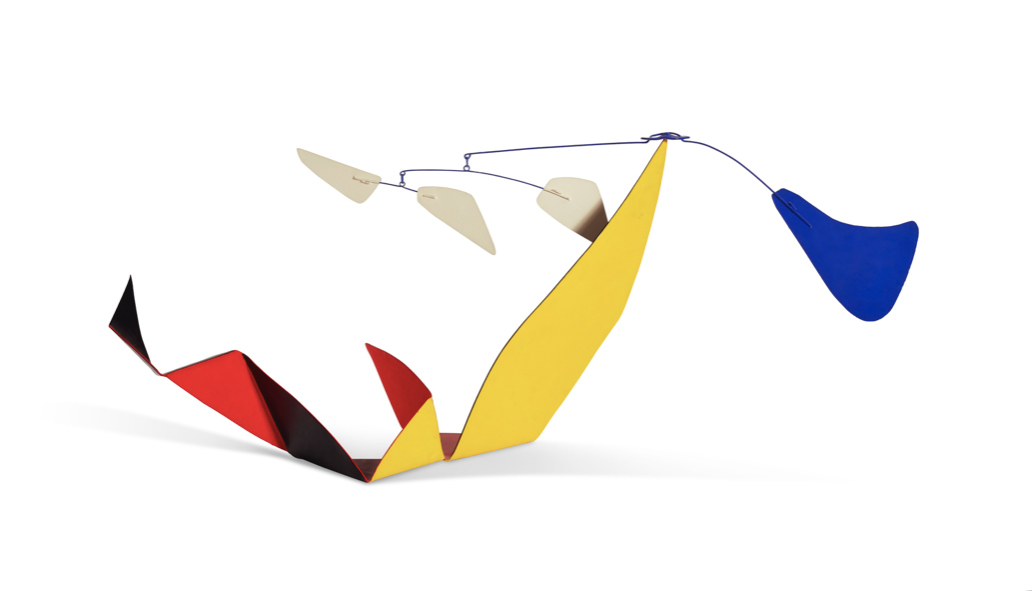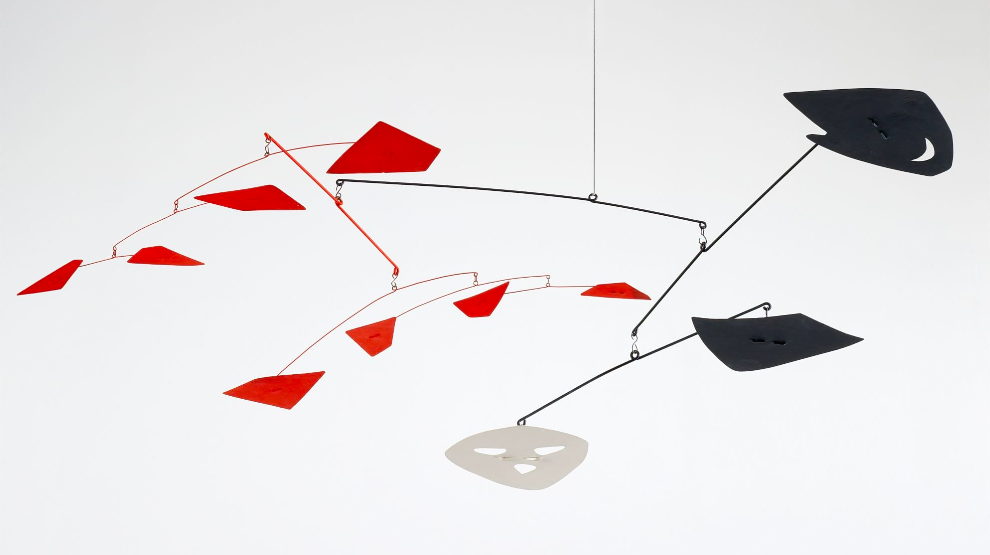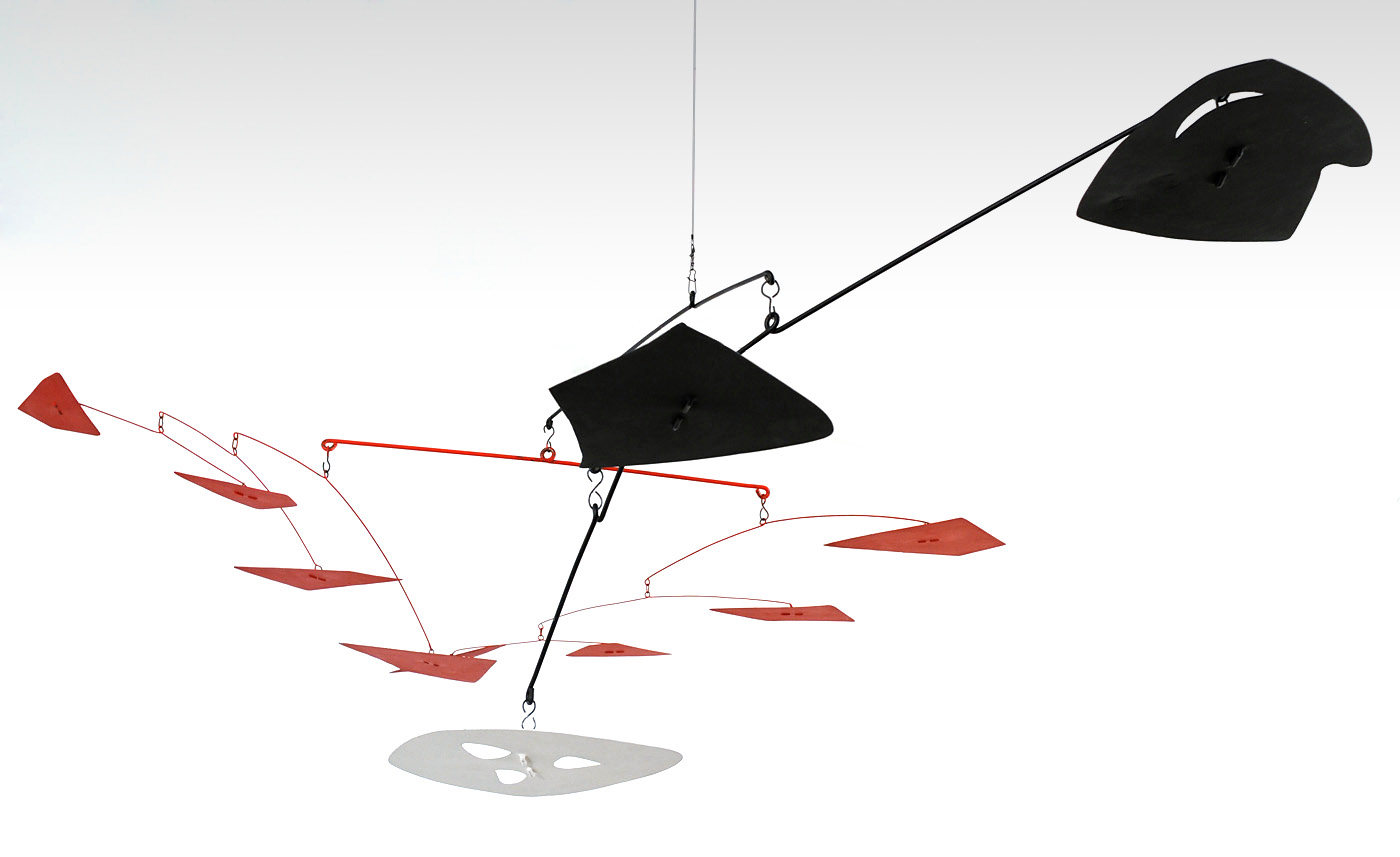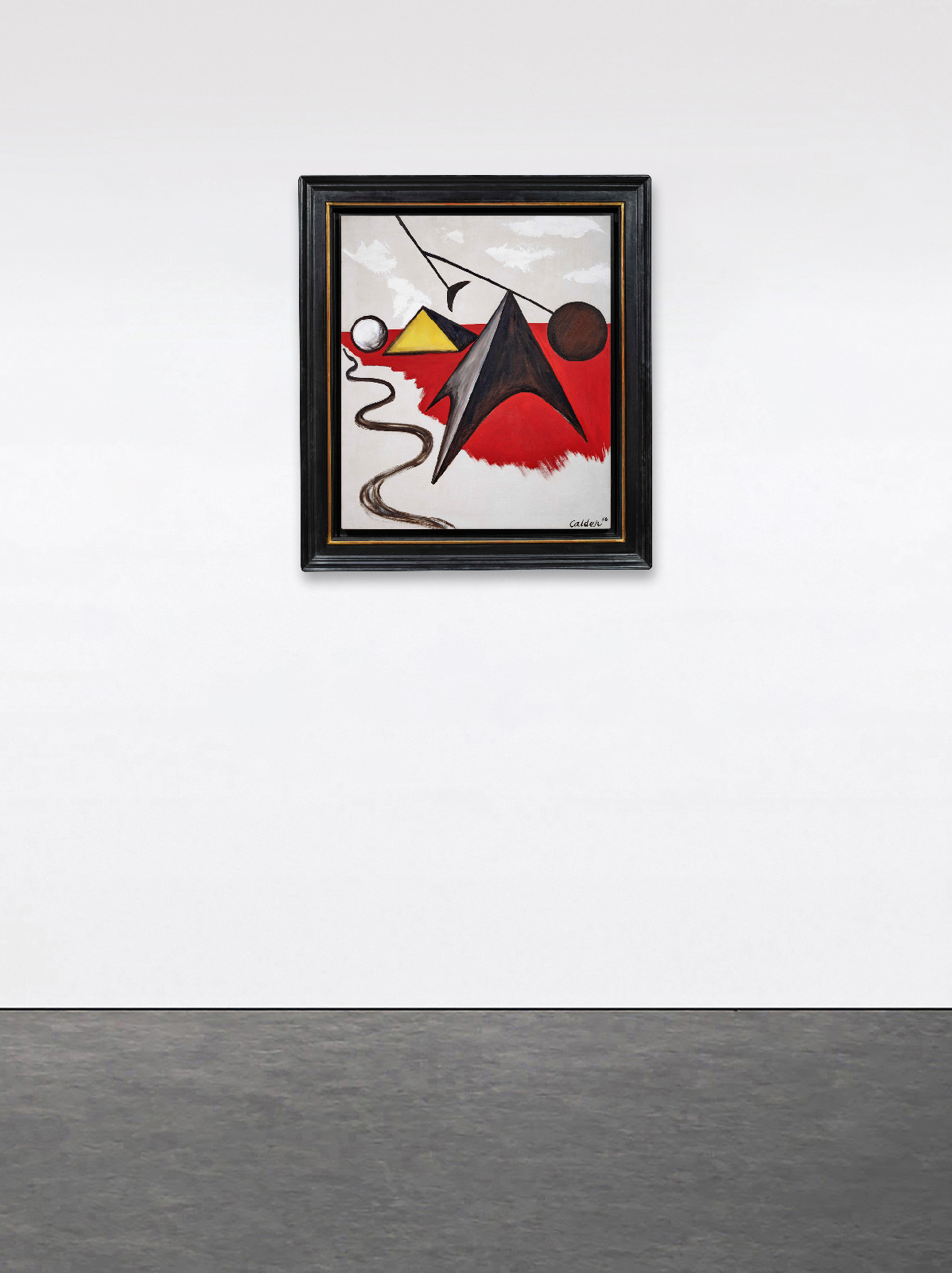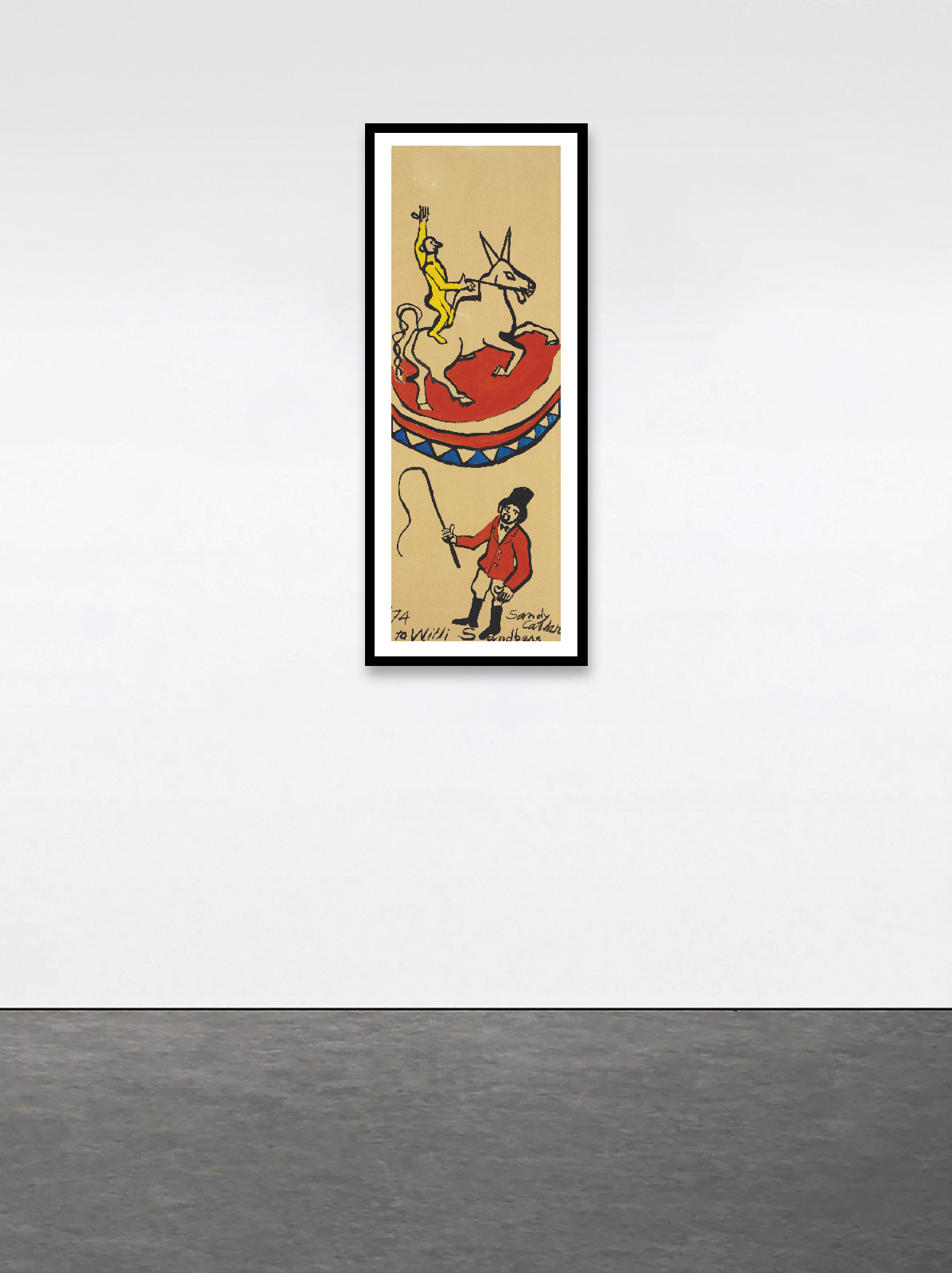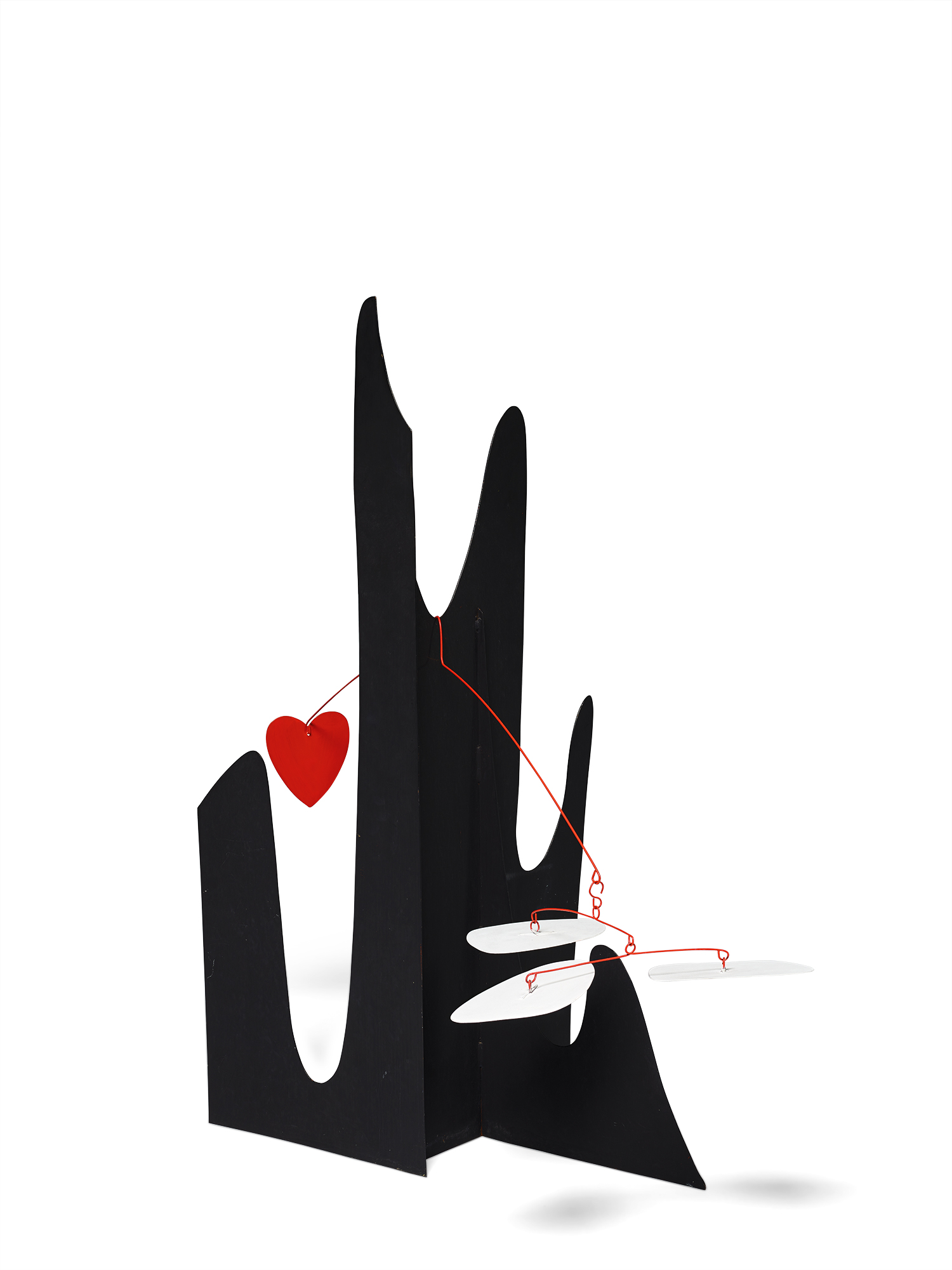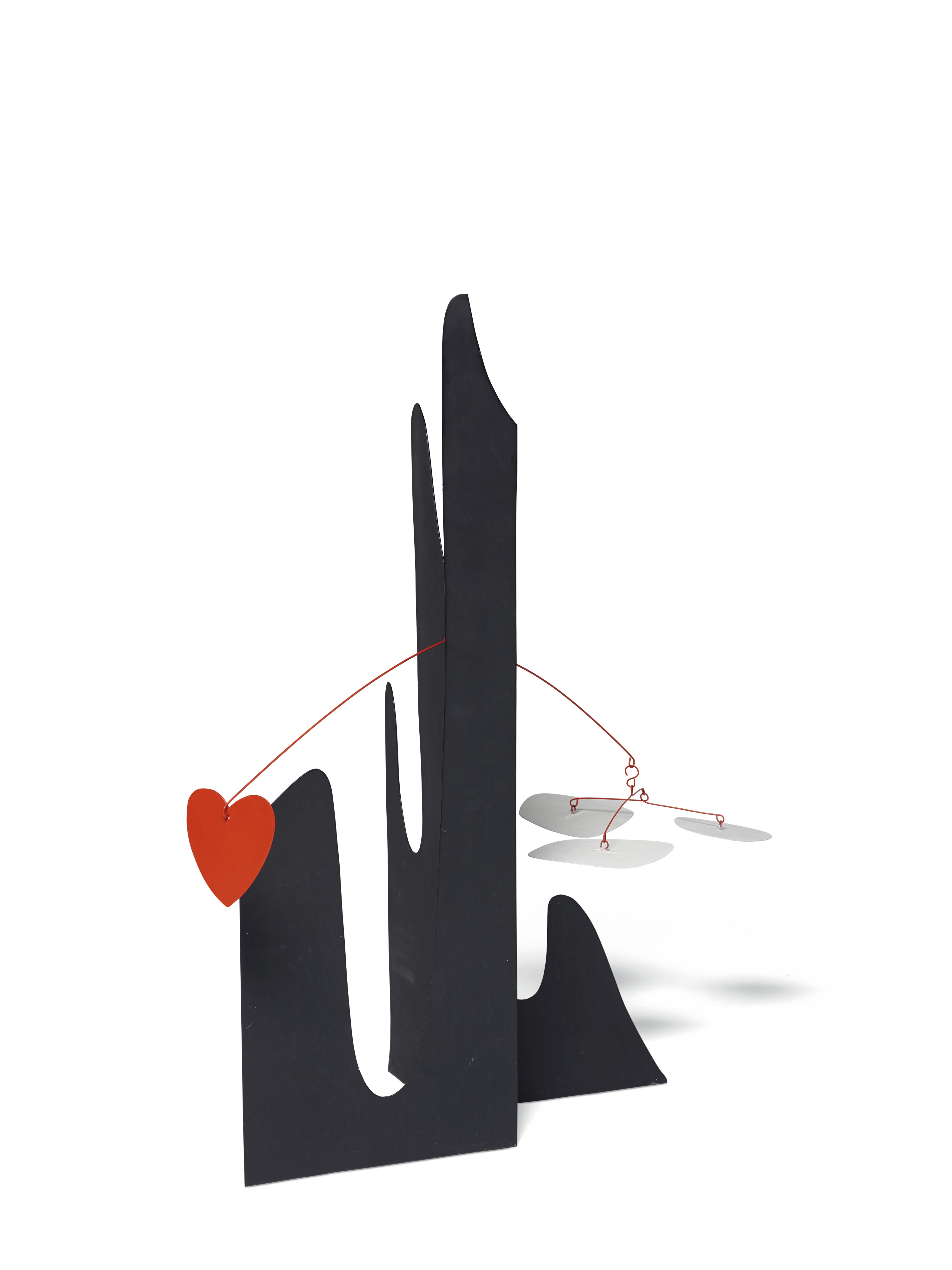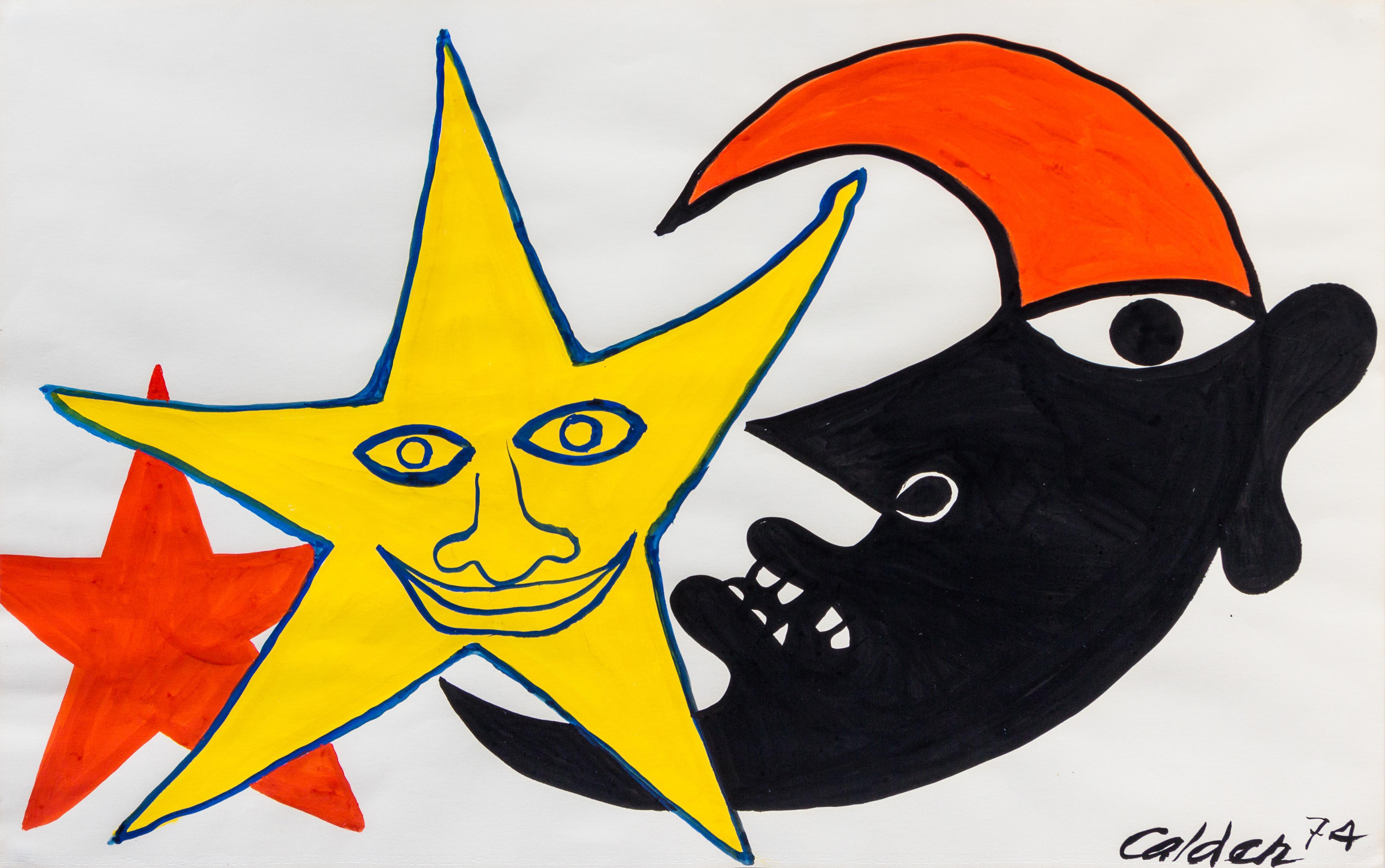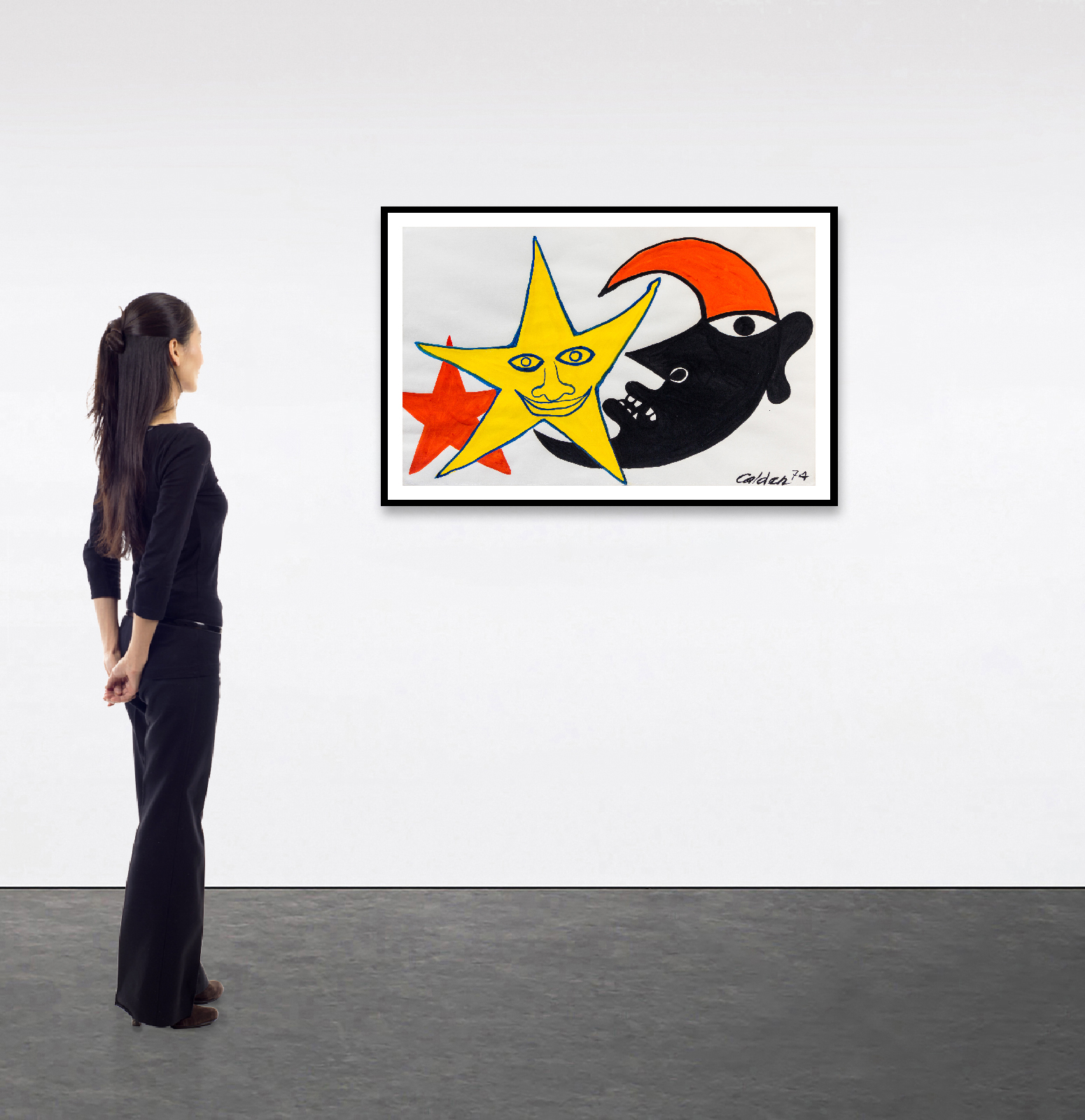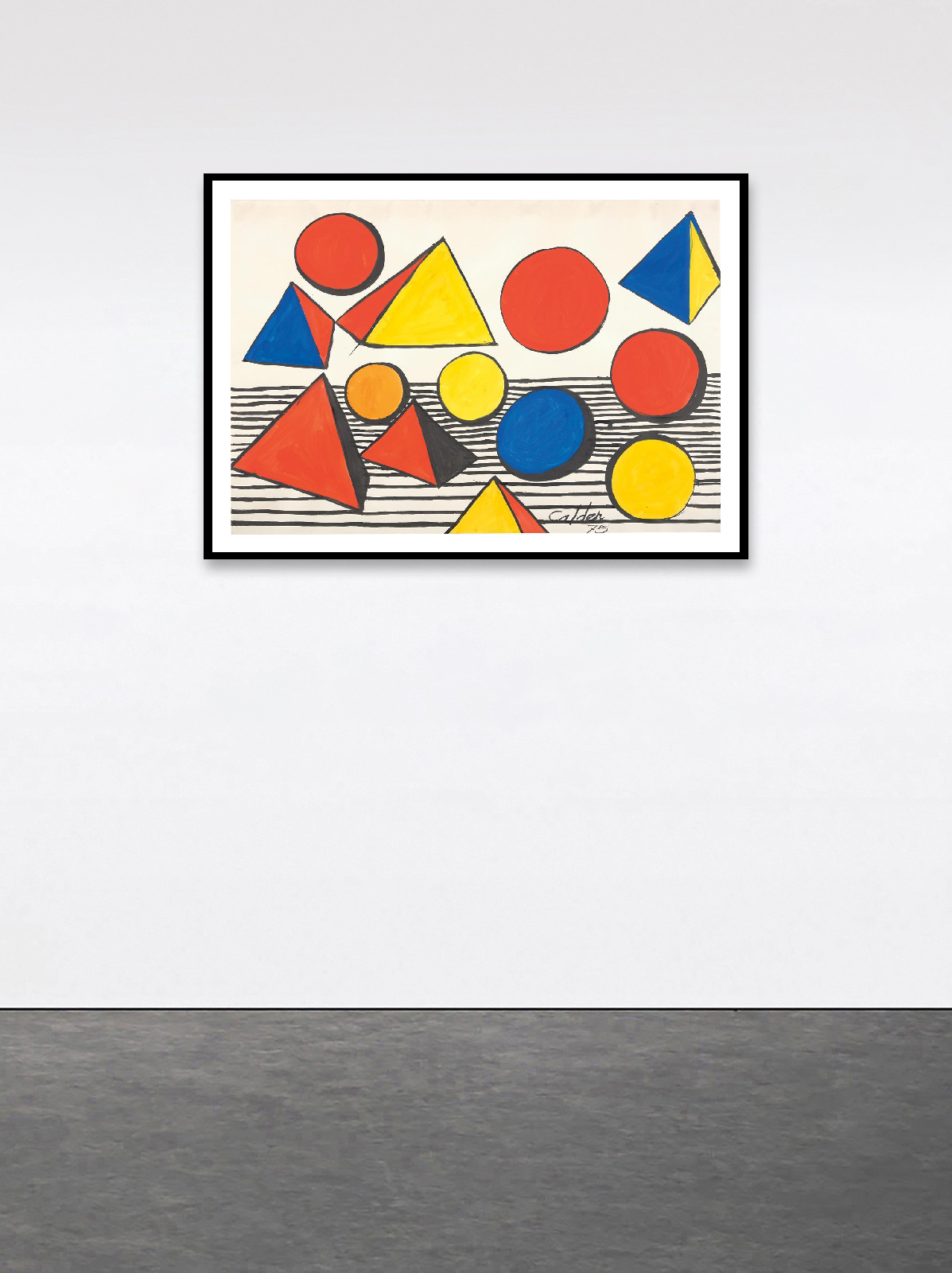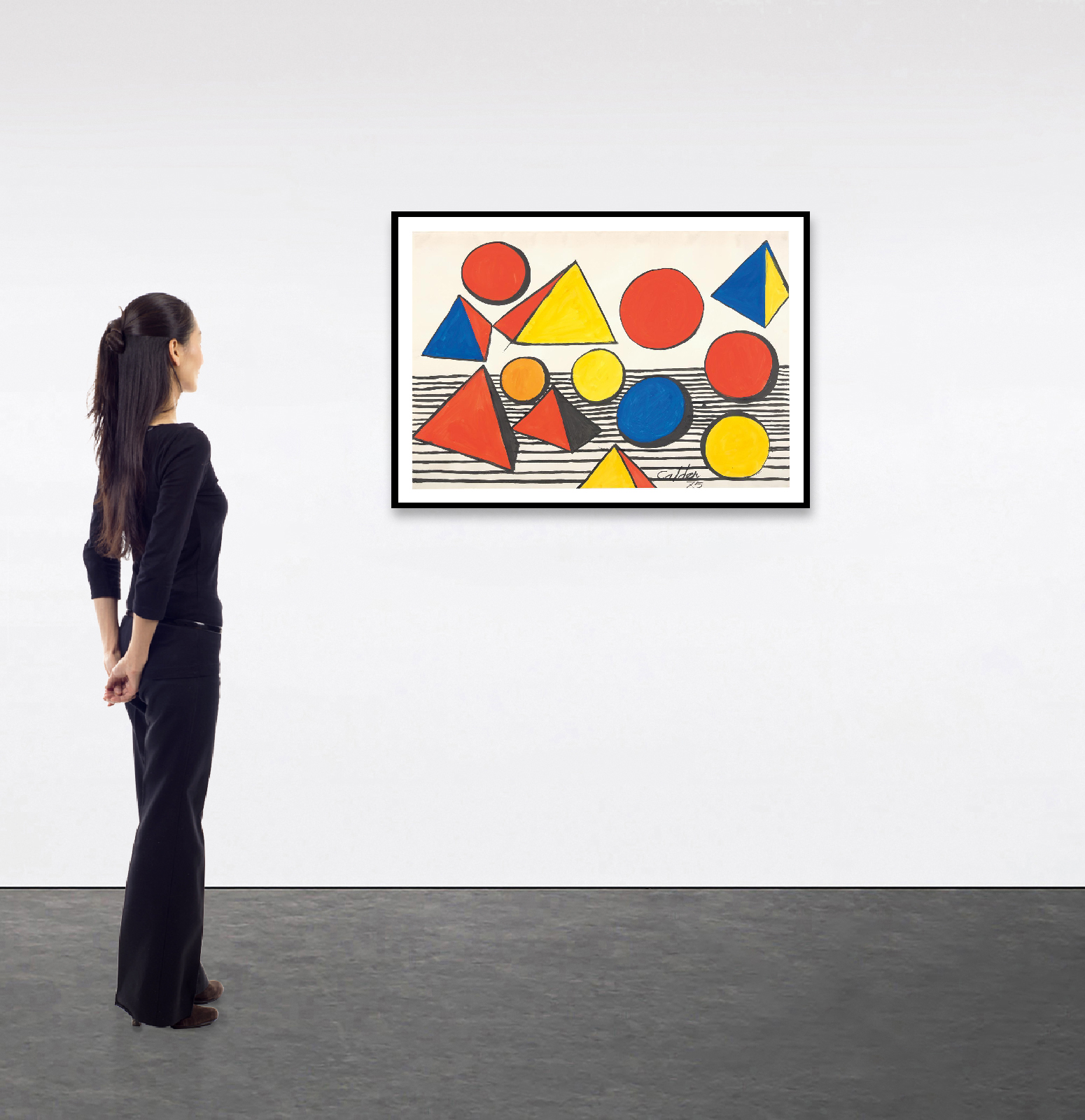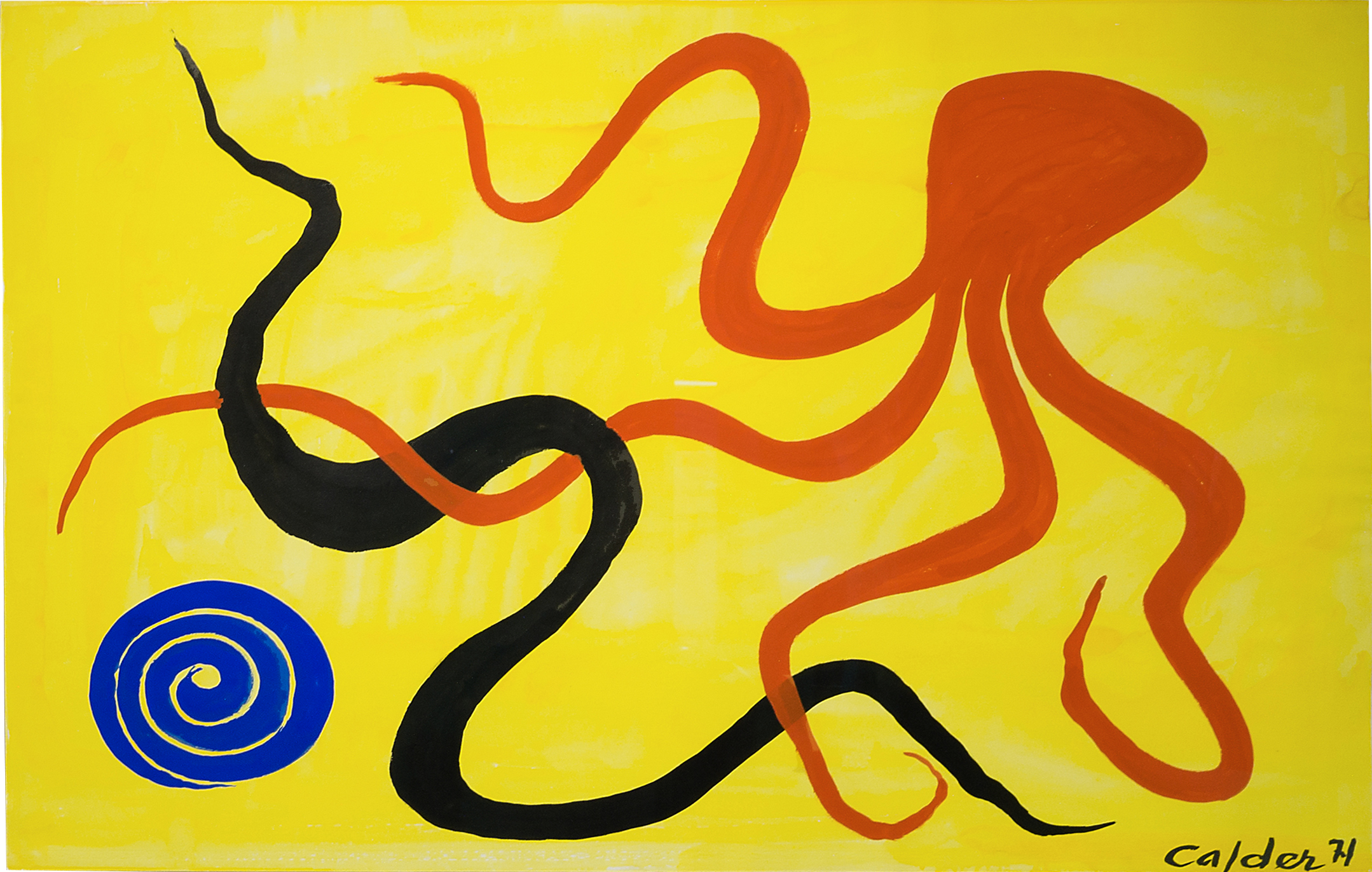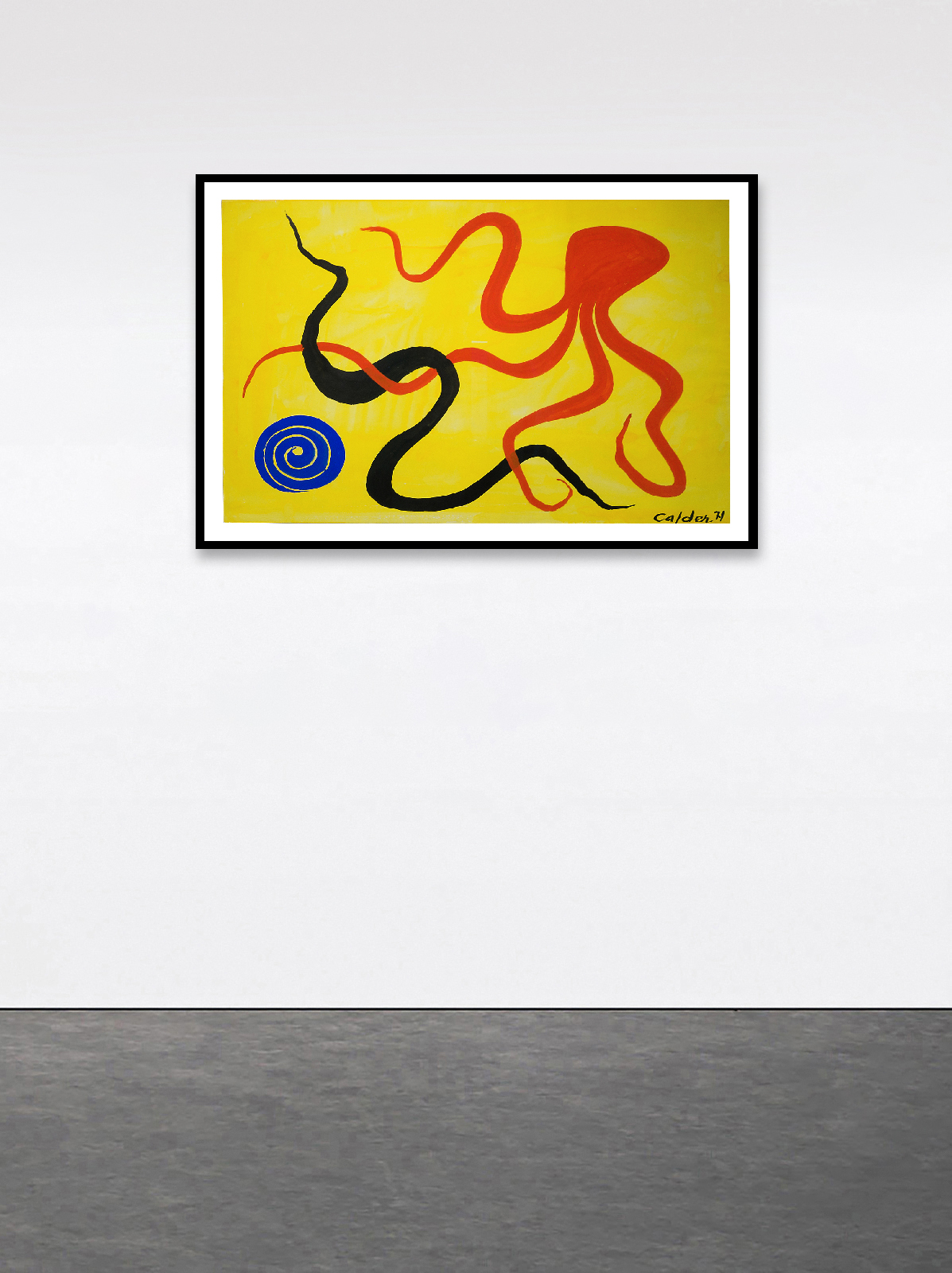Alexander Calder is undoubtedly one of the most fascinating artists of the twentieth century. Best
known for his innovative kinetic sculptures powered by air currents, the "mobiles" and his colorful,
whimsical abstract monumental sculptures, or "stabile", Calder was a prodigious artist with a
restless creative spirit. Informed by a singular hand defying any attempt at categorization, his
diverse practice also included painting, mostly gouache, printmaking, miniatures (such as his famous
Cirque Calder), children's book illustrations, theater set design, jewelry design and more. His
unique abstract language, brimming with dynamism and vibrancy is based on the intuitive use of pure
color, gesture, and line, which extends between subtle biomorphic shapes and geometric forms.
Alexander Calder
Double Humpbacked Crinkly1970
Sheet metal, wire and paint
45,7 x 110,5 x 86,4 cm | 18 x 43.5 x 34 in
Alexander Calder
The White Face1969
Hanging mobile, painted sheet metal, rod, wire overall
55,9 x 289,6 x 134,6 cm | 22 x 114 x 53 in

Credits 2021 Calder Foundation New York, / Artists Rights Society (ARS) New York
Publicity photograph of Calder during the installation of Alexander Calder (September 29, 1943–January 16,
1944). 1943. Gelatin silver print, 3 3/4 x 4 3/4″. Photographic Archive, The Museum of Modern Art Archives,
New York.
Credits 2021 Calder Foundation New York, / Artists Rights Society (ARS) New York
Publicity photograph of Calder during the installation of Alexander Calder (September 29, 1943–January 16,
1944). 1943. Gelatin silver print, 3 3/4 x 4 3/4″. Photographic Archive, The Museum of Modern Art Archives,
New York.
Alexander Calder
Pyramidal Shapes1956
Oil on canvas
76,2 x 66 cm | 30 x 26 in
Pyramidal shapes present a lively array of simple geometric shapes rendered in vibrant color, a
compositional theme Calder depicted frequently and with great effectiveness in his graphic art. The
slightly off-kilter arrangement of solid forms coupled with sinuous lines and sharply contrasting
colors animates this image with a tangible sense of energy similar to the movement in his
sculptures.
Alexander Calder
Untitled (maquette)1975
Stabile-sheet metal and bolts
92 x 74,9 x 61,6 cm | 36.2 x 29.5 x 24.2 in

Calder Foundation, New York / Artists Rights Society (ARS), New York. La photo a été prise
au Whitney Museum of American Art.
Calder Foundation, New York / Artists Rights Society (ARS), New York. La photo a été prise
au Whitney Museum of American Art.
While studying at the Art Students League in New York in the mid-1920s, Calder took a job
illustrating for the National Police Gazette, which sent him to the Ringling Bros. and Barnum &
Bailey Circus to sketch the troupes. This sparked a lifelong interest in this milieu. In 1926 in
Paris, he created a complex, movable, miniature "Circus" in wire, and he went on producing drawings
and paintings of circus subjects throughout his career.
Explaining his fascination with the circus, Calder said: It wasn't the daringness of the performers, nor the tricks and gimmicks, it was the fantastic balance in motion that the performers exhibited.
Explaining his fascination with the circus, Calder said: It wasn't the daringness of the performers, nor the tricks and gimmicks, it was the fantastic balance in motion that the performers exhibited.
Alexander Calder
Untitled1974
Gouache on paper
109,8 x 37,7 cm | 43.2 x 14.8 in

Credits 2021 Calder Foundation New York, / Artists Rights Society (ARS) New York, Calder
with Gamma and Sword Plant, Buchholz Gallery / Curt Valentin, New York - 1947
Credits 2021 Calder Foundation New York, / Artists Rights Society (ARS) New York, Calder
with Gamma and Sword Plant, Buchholz Gallery / Curt Valentin, New York - 1947
Just as one can compose colors, or forms, so one can compose motions
Alexander Calder
Rocher au cœur rouge1974
Painted metal and wire
108 x 111 x 68,5 cm | 42.5 x 43.7 x 27 in
Alexander Calder
Black Heart1971
Sheet metal and paint
59,7 x 33 x 25,4 cm | 23.5 x 13 x 10 in

Alexander Calder with Snow Flurry, 1966. Photo by Yousuf Karsh. Artwork © 2020 Calder
Foundation, New York / Artists Rights Society (ARS), New York.
Alexander Calder with Snow Flurry, 1966. Photo by Yousuf Karsh. Artwork © 2020 Calder
Foundation, New York / Artists Rights Society (ARS), New York.
The basis of everything I do is the universe.
Alexander Calder
Mirobolant1974
Gouache and ink on paper
74 x 110,5 cm | 29.1 x 43.5 in

Highly regarded for their immediacy and purity of colour, line and form, the gouaches are an
integral component of Calder's oeuvre, reflecting and inspiring the sculptural practice for which he
is renowned.
Alexander Calder
Joliette1975
Gouache and ink on paper
74,9 x 109,5 cm | 29.5 x 43.1 in
Alexander Calder
Red Octopus1971
Gouache on paper
75 x 109 cm | 29.5 x 43 in
Alexander Calder was an American sculptor and painter born in 1898 in Lawnton, Pennsylvania. In 1919, he
received an engineering degree from Stevens Institute of Technology, Hoboken, New Jersey and from 1923 to
1925, he attended the Art Students League, New York. He lived and worked mostly in the United States and in
France. He died in 1976 in New York city.
Calder's public commissions are on view in cities all over the world and his work has been the subject of numerous museum exhibitions, including the National Gallery of Art, Washington, D.C. (1998, traveled to San Francisco Museum of Modern Art, California); The Phillips Collection, Washington, D.C. (1998–99); Wadsworth Atheneum Museum of Art, Hartford (2000); Museum of Contemporary Art, Chicago (2000); Iwaki City Art Museum, Japan (2000, traveled to The Museum of Modern Art, Japan; Hokkaido Obihiro Museum of Art, Japan; The Museum of Art, Japan; Hiroshima Prefectural Art Museum, Japan; Nagoya City Art Museum, Japan); Storm King Art Center, New York (2001–03); Guggenheim Museum, Bilbao (2003, traveled to Museo Nacional Centro de Arte Reina Sofía, Madrid, through 2004); Foundation Beyeler, Switzerland (2004, traveled to Phillips Collection, Washington, D.C., through 2005); Los Angeles County Museum of Art, California (2013); Rijksmuseum, Amsterdam (2014); Fondation Beyeler, Basel (2014); Museo Jumex, Mexico City (2015); and Pulitzer Arts Foundation, Saint Louis (2015).
Calder's public commissions are on view in cities all over the world and his work has been the subject of numerous museum exhibitions, including the National Gallery of Art, Washington, D.C. (1998, traveled to San Francisco Museum of Modern Art, California); The Phillips Collection, Washington, D.C. (1998–99); Wadsworth Atheneum Museum of Art, Hartford (2000); Museum of Contemporary Art, Chicago (2000); Iwaki City Art Museum, Japan (2000, traveled to The Museum of Modern Art, Japan; Hokkaido Obihiro Museum of Art, Japan; The Museum of Art, Japan; Hiroshima Prefectural Art Museum, Japan; Nagoya City Art Museum, Japan); Storm King Art Center, New York (2001–03); Guggenheim Museum, Bilbao (2003, traveled to Museo Nacional Centro de Arte Reina Sofía, Madrid, through 2004); Foundation Beyeler, Switzerland (2004, traveled to Phillips Collection, Washington, D.C., through 2005); Los Angeles County Museum of Art, California (2013); Rijksmuseum, Amsterdam (2014); Fondation Beyeler, Basel (2014); Museo Jumex, Mexico City (2015); and Pulitzer Arts Foundation, Saint Louis (2015).
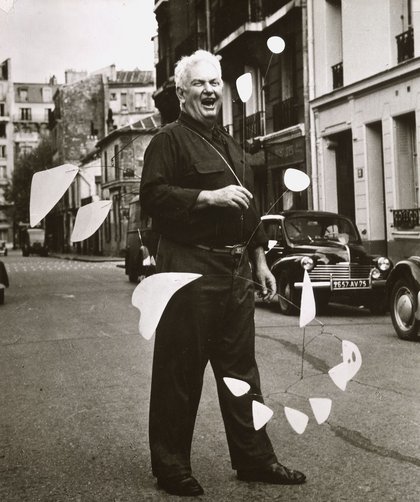
Alexander Calder with 21 feuilles blanches Paris 14ème Photo
credits : Agnès Varda, 1953 - Image : Courtesy Calder Foundation, New York / Art Resource, New York,
2015 Calder Foundation, New York / DACS London.


